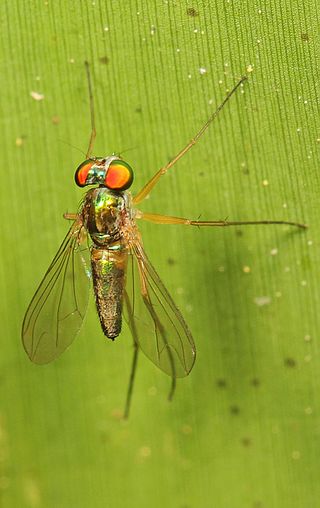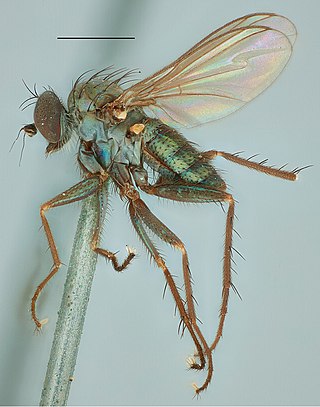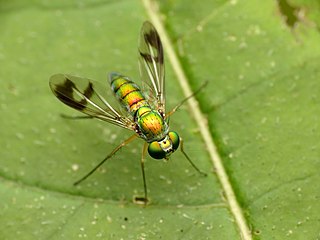
Amblypsilopus is a genus of flies in the family Dolichopodidae. It is a large genus, with about 350 species recorded. However, it is possibly polyphyletic.

Aphrosylus is a genus of flies in the family Dolichopodidae. All species are intertidal in habitat.

Asyndetus is a genus of flies in the family Dolichopodidae. There are more than 100 species described for the genus, distributed worldwide.

Condylostylus is a genus of flies in the family Dolichopodidae. It is the second largest genus in the subfamily Sciapodinae, with more than 250 species included. It has a high diversity in the Neotropical realm, where 70% of the species occur.
Cymatopus is a genus of flies in the family Dolichopodidae. Members of the genus are found on rocky coasts of the Indo-West Pacific.
Gigantosciapus is a genus of flies in the family Dolichopodidae.

Medetera is a large genus of flies in the family Dolichopodidae. It includes about 350 species worldwide. The adults are commonly found resting on vertical surfaces such as tree trunks, on which they have a characteristic vertical upright stance. Because of this stance, they are sometimes known as "woodpecker flies". Medetera adults are predators of soft-bodied arthropods, while the larvae are predators of bark beetle larvae.

Rhaphium is a genus of flies in the family Dolichopodidae. It is the largest genus within the subfamily Rhaphiinae, with over 200 species currently known.
Saccopheronta is a genus of flies in the family Dolichopodidae. It is considered a synonym of Medetera by some authors, and a valid genus by others.
Tenuopus is a genus of flies in the family Dolichopodidae. It is the only genus in the subfamily Tenuopodinae, which was created by Igor Grichanov in 2018. The genus was previously placed in the subfamily Neurigoninae, and it also shares some features of Peloropeodinae and Sciapodinae. All species are known from the Afrotropical realm.

Thinophilus is a genus of flies in the family Dolichopodidae. It includes about 146 described species distributed worldwide. Most species of the genus are found in coastal habitats, while a few species are found in freshwater habitats.
Trigonocera is a genus of flies in the family Dolichopodidae. It is known from the Afrotropical, Oriental and Palaearctic realms.

Hydrophorinae is a subfamily of flies in the family Dolichopodidae. Several molecular phylogenetic analyses of the family have found evidence that the subfamily in its current sense is polyphyletic.

Sciapodinae is a subfamily of flies in the family Dolichopodidae. Members of the subfamily possess several ancestral characteristics of the family, such as branched vein M1+2 in the wings (though M2 is absent or reduced in Mesorhagini) and a pedunculate hypopygium. They also typically have a deeply excavated vertex, giving their heads the appearance of a dumbbell when viewed from the front.

Medeterinae is a subfamily of flies in the family Dolichopodidae.
Apelastoneurus is a genus of flies in the family Dolichopodidae. It includes 47 species from Africa formerly placed in Paracleius or Pelastoneurus.
Pseudoparaclius is a genus of flies in the family Dolichopodidae. It was established by Igor Grichanov in 2006, for 14 species from Africa that were originally placed in Paracleius. Two additional species were described in 2015 and 2020.
Afrohercostomus is a genus of flies in the family Dolichopodidae. Many of the species were formerly from "Hercostomus Group I", one of three groups of Afrotropical Hercostomus species created by Igor Grichanov in 1999.

Chrysosomatini is a tribe of flies in the family Dolichopodidae.









